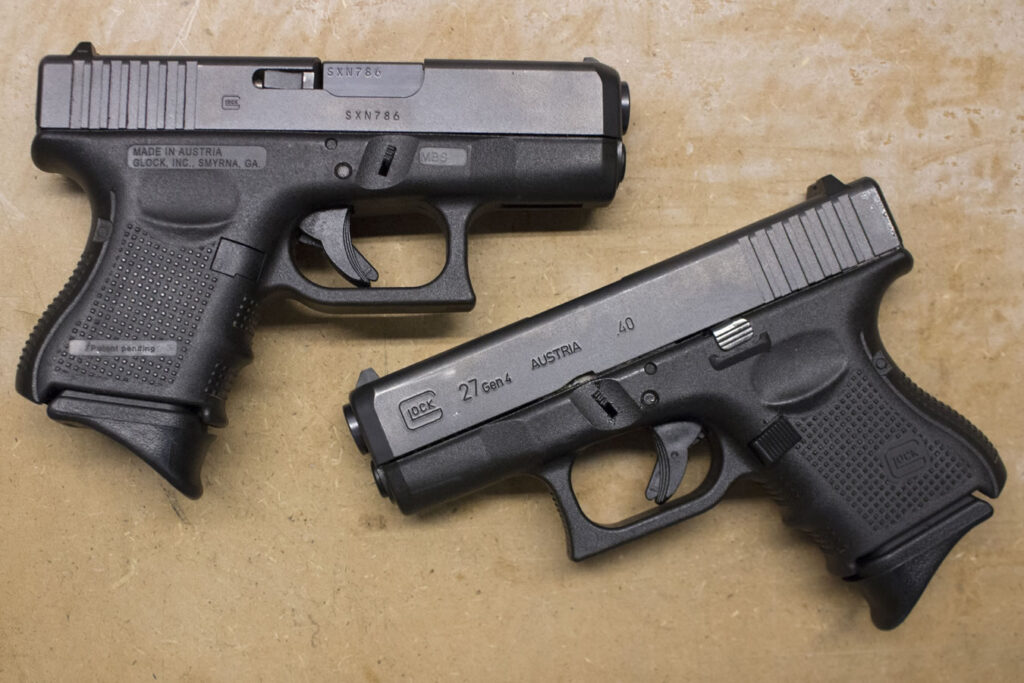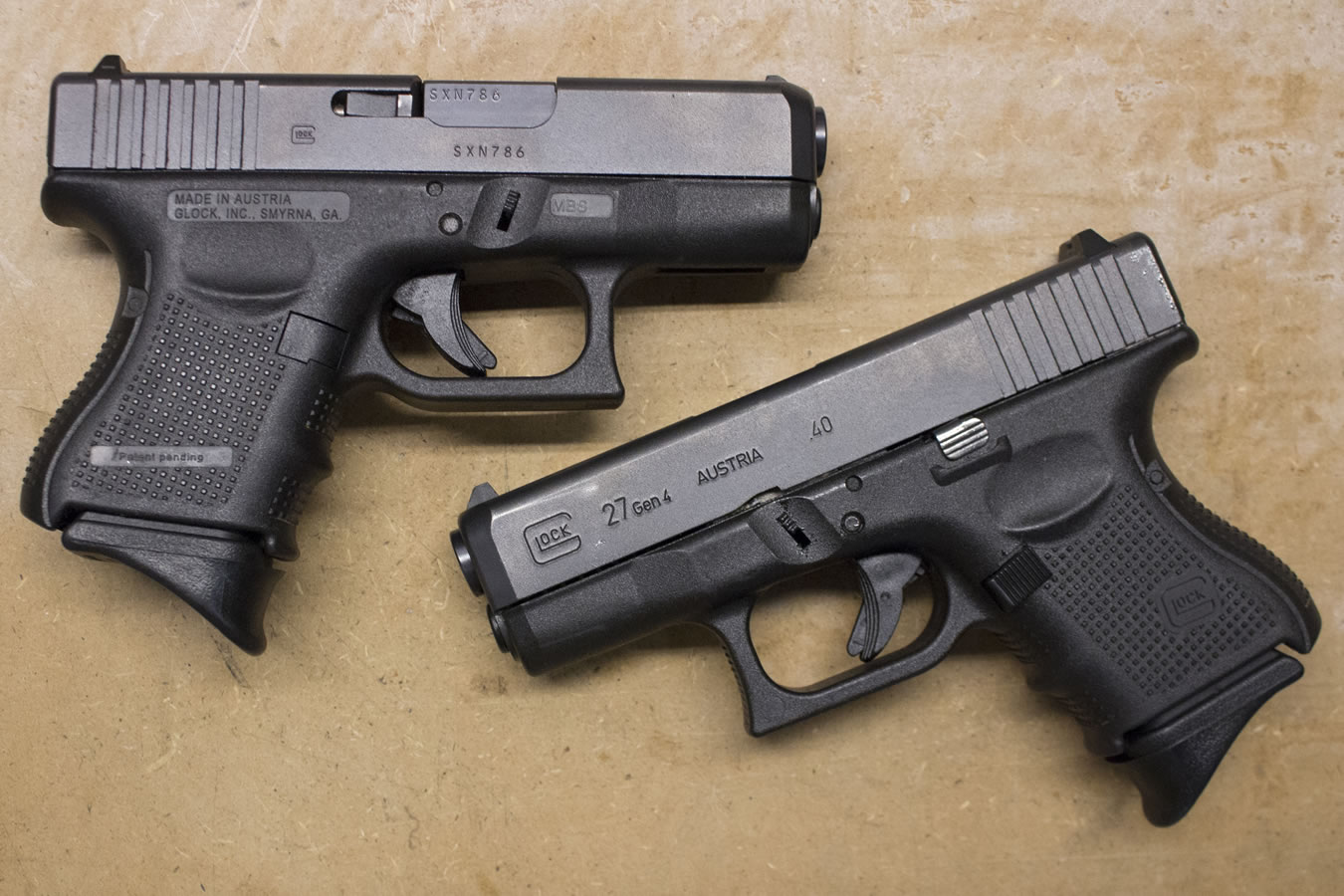
Glock 26 vs 27: A Detailed Comparison for Concealed Carry Enthusiasts
For concealed carry enthusiasts, selecting the right handgun is a critical decision. The Glock 26 and Glock 27, both subcompact pistols from the renowned Glock family, are frequently compared. This article provides a detailed, objective comparison of the Glock 26 vs 27, exploring their features, performance, and suitability for various concealed carry needs. Understanding the nuances between these two models is essential for making an informed choice.
Overview of the Glock 26
The Glock 26, often referred to as the “Baby Glock,” is a 9mm subcompact pistol designed for concealed carry. Introduced in 1996, it quickly gained popularity due to its small size, reliability, and Glock’s reputation for durability. Its compact dimensions make it easy to conceal, while still offering a reasonable capacity for self-defense.
- Caliber: 9mm
- Capacity: 10+1 rounds (standard magazine)
- Barrel Length: 3.43 inches
- Overall Length: 6.41 inches
- Width: 1.26 inches
- Height: 4.17 inches
- Weight (unloaded): 21.71 ounces
Overview of the Glock 27
The Glock 27 is the .40 S&W counterpart to the Glock 26. Sharing the same frame size and dimensions, the Glock 27 offers a more potent cartridge in a subcompact package. This makes it an attractive option for those who prioritize stopping power in a smaller firearm.
- Caliber: .40 S&W
- Capacity: 9+1 rounds (standard magazine)
- Barrel Length: 3.43 inches
- Overall Length: 6.41 inches
- Width: 1.26 inches
- Height: 4.17 inches
- Weight (unloaded): 21.99 ounces
Key Differences: Caliber and Capacity
The most significant difference between the Glock 26 vs 27 is the caliber. The Glock 26 is chambered in 9mm, a widely popular and readily available cartridge known for its manageable recoil and higher capacity. The Glock 27, on the other hand, is chambered in .40 S&W, a cartridge with more recoil but also greater energy transfer, potentially offering increased stopping power. The Glock 26 holds 10 rounds in its standard magazine, while the Glock 27 holds 9 rounds. This difference in capacity, though seemingly small, can be a factor for some shooters.
Size and Dimensions: A Tie
In terms of size and dimensions, the Glock 26 and Glock 27 are virtually identical. Both pistols share the same frame, barrel length, overall length, width, and height. This means that holster compatibility and concealability are essentially the same for both models. The slight difference in weight is negligible.
Recoil and Handling
Recoil is a crucial factor to consider when choosing a handgun, especially for concealed carry. The Glock 26, chambered in 9mm, generally exhibits less recoil than the Glock 27. This makes the Glock 26 easier to control, especially during rapid fire. The .40 S&W cartridge in the Glock 27 produces more felt recoil, which can be challenging for some shooters, potentially affecting accuracy and follow-up shot speed. However, experienced shooters may find the recoil manageable and prefer the perceived increase in stopping power.
Accuracy and Performance
Both the Glock 26 and Glock 27 are capable of excellent accuracy in the hands of a skilled shooter. The shorter barrel length of these subcompact pistols can present a challenge for some, but with practice, consistent groupings are achievable. The 9mm round in the Glock 26 is generally considered more forgiving, allowing for quicker target acquisition and follow-up shots due to the reduced recoil. The .40 S&W round in the Glock 27 requires more attention to recoil management, but can still deliver accurate shots with proper technique. [See also: Glock Accuracy Testing]
Concealability
Both the Glock 26 and Glock 27 excel in concealability due to their subcompact size. Their small dimensions make them easy to carry in a variety of concealed carry positions, such as inside the waistband (IWB), appendix carry, or even in an ankle holster. The choice between the two ultimately comes down to personal preference regarding caliber and recoil management, as their concealability is virtually identical.
Reliability
Glock pistols are renowned for their reliability, and both the Glock 26 and Glock 27 are no exception. Both models feature Glock’s simple and robust design, making them resistant to malfunctions. Regular maintenance and proper ammunition selection are, of course, important for ensuring consistent reliability. The Glock 26 and 27 both are known for their ability to function reliably under various conditions.
Ammunition Availability and Cost
Ammunition availability and cost are important considerations for any firearm owner. 9mm ammunition, used by the Glock 26, is generally more readily available and less expensive than .40 S&W ammunition, used by the Glock 27. This can make the Glock 26 a more economical choice for frequent practice and training. While .40 S&W ammunition is still widely available, it typically commands a higher price point. [See also: Ammunition Cost Comparison]
Aftermarket Support
Glock pistols enjoy extensive aftermarket support, and both the Glock 26 and Glock 27 benefit from this. A wide range of accessories, such as sights, triggers, and extended magazines, are readily available for both models. This allows owners to customize their pistols to suit their individual needs and preferences.
Choosing Between the Glock 26 and Glock 27: Key Considerations
When deciding between the Glock 26 vs 27, consider the following factors:
- Recoil Tolerance: If you are sensitive to recoil, the Glock 26 (9mm) is likely a better choice.
- Stopping Power Preference: If you prioritize stopping power and are comfortable with more recoil, the Glock 27 (.40 S&W) may be more appealing.
- Ammunition Cost and Availability: 9mm ammunition is generally more affordable and readily available than .40 S&W.
- Intended Use: Consider the primary purpose of the handgun. For self-defense, both calibers are effective, but personal preference plays a significant role.
- Training and Practice: Regular practice is essential for proficiency with any handgun. The lower recoil of the Glock 26 may make it easier to train with more frequently.
Conclusion: A Matter of Personal Preference
The Glock 26 vs 27 debate ultimately comes down to personal preference. Both pistols offer a compact and reliable platform for concealed carry. The Glock 26 provides a more manageable recoil and higher capacity with the readily available 9mm cartridge, while the Glock 27 offers a potentially more potent .40 S&W cartridge. Carefully consider your individual needs, recoil tolerance, and budget when making your decision. Whichever model you choose, ensure you receive proper training and practice regularly to develop proficiency and confidence in your chosen firearm. [See also: Concealed Carry Tips and Techniques]

